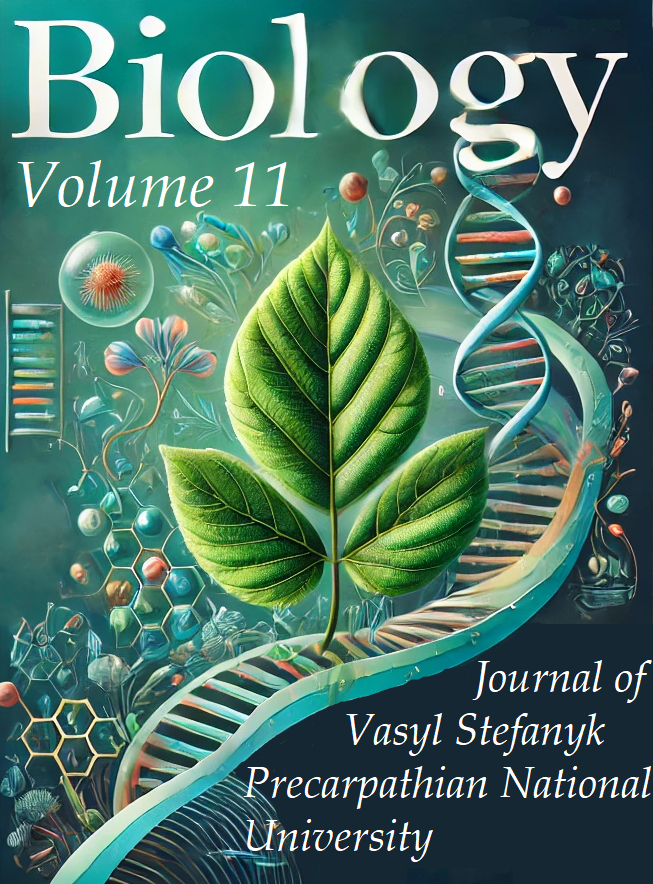Forest reclamation of technogenic lands: a case study of ash and slag dumps
DOI:
https://doi.org/10.15330/jpnubio.11.146-155Keywords:
forest reclamation, phytorecultivation, technogenic landscapes, ecological restorationAbstract
Forest reclamation of technogenic landscapes represents a considerable ecological intervention, addressing environmental challenges caused by industrial transformation of the environment. This comprehensive study investigates vegetation restoration and ecological rehabilitation on ash and slag dumps of the Burshtyn Thermal Power Plant, revealing innovative strategies for ecosystem recovery with forest reclamation in severely degraded environments. The research explores spontaneous succession and strategic phytorecultivation, analyzing the species diversity and ecological characteristics of woody vegetation on ash and slag dumps. Surprisingly, native species predominated (65 % of tree species), challenging previous assumptions about vegetation restoration in anthropogenically transformed landscapes. Pioneer species like Betula pendula, Salix caprea and Populus spp. emerged as critical agents of ecological transformation, capable of rapidly establishing vegetation cover and initiating complex successional processes. Nitrogen-fixing species such as Alnus glutinosa and Hippophae rhamnoides were highlighted for their unique ability to restore ecosystems on technogenic substrates. The study recommends a diverse ensemble of tree and shrub species with exceptional adaptive capabilities, demonstrating a sophisticated biological approach to landscape restoration. Practical recommendations include strategic species selection, understanding spontaneous succession dynamics and implementing supplementary restoration techniques. By providing a comprehensive framework for ecological restoration, this research contributes to environmental management and sustainable landscape rehabilitation, offering innovative approaches to transforming degraded industrial territories into functional ecosystems.
References
Adams, M. B. (Ed.). (2017). The Forestry Reclamation Approach: guide to successful reforestation of mined lands. U.S. Department of Agriculture, Forest Service, Northern Research Station. https://doi.org/10.2737/NRS-GTR-169
Alday, J., Santana, V., Marrs, R., & Ruiz, C. (2014). Shrub-induced understory vegetation changes in reclaimed mine sites. Ecological Engineering, 73, 691–698. https://doi.org/10.1016/j.ecoleng.2014.09.079
Aronson, J., Clewell, A., & Moreno-Mateos, D. (2016). Ecological restoration and ecological engineering: Complementary or indivisable? Ecological Engineering, 91, 392-395. https://doi.org/10.1016/j.ecoleng.2016.02.043
Bhatia, U., Dubey, S., Gouhier, T. C., et al. (2023). Network-based restoration strategies maximize ecosystem recovery. Communications Biology, 6, 1256. https://doi.org/10.1038/s42003-023-04300-0
Brown, R. W., & Amacher, M. C. (2010). Selecting plant species for ecological restoration: A perspective for land managers. Restoration Ecology, 18(3), 300-310. https://doi.org/10.1111/j.1526-100X.2009.00583.x
Center for Ecology and Development of New Technologies. (2019). Environmental Impact Assessment Report for Ash Dump Buildings 1–2 (reconstruction) "Burshtynska TPP" "DTEK ZAKHIDENERGO".
Didukh, Y. P. (Ed.). (2000-2010). Ecoflora of Ukraine. Vol. 1-6. Phytosociocentr.
Gajic, G., Djurdjević, L., Kostic, O., Jarić, S., Mitrović, M., & Pavlović, P. (2018). Ecological Potential of Plants for Phytoremediation and Ecorestoration of Fly Ash Deposits and Mine Wastes. Frontiers in Environmental Science, 6, 124. https://doi.org/10.3389/fenvs.2018.00124
Kiehl, K., Kirmer, A., Donath, T. W., & Hölzel, N. (2010). Species introduction in restoration projects: Evaluation of different techniques for the establishment of semi-natural grasslands in Central and Northwestern Europe. Basic and Applied Ecology, 11(4), 285-299. https://doi.org/10.1016/j.baae.2009.12.004
Kirmer, A., Jeschke, D., Kiehl, K., & Tischew, S. (2019). Praxisleitfaden zur Etablierung und Aufwertung von Säumen und Feldrainen (2nd ed.). Hochschule Anhalt. ISBN 978-3-86011-075-1.
Klotz, S., Kühn, I. and Durka, W. 2002 (eds.). BIOLFLOR – Eine Datenbank zu biologisch-ökologischen Merkmalen der Gefäßpflanzen in Deutschland. Schriftenreihe für Vegetationskunde 38. Bonn: Bundesamt für Naturschutz. 334 pp.
Kovaliv, L. N. (2013). Environmental problems of thermal power. Scientific Bulletin of UNFU, 23(18), 57–56.
Krasova, O. O., Shkuta, S. I., & Pavlenko, A. O. (2022). The current state of coenopopulations of shrubs of family Rosaceae Juss. on the iron ore dumps of Kryvyi rih area. Scientific Bulletin of UNFU, 32(5), 07–12. https://doi.org/10.36930/40320501
Lin, Y., Fang, L., Zhou, W., Qiao, Z., Chang, Y., Yu, X., Li, Y., Ren, P., & Xiao, J. (2024). Evaluating the long-term effects of near-natural restoration on post-fire forest dynamics in a wildland-urban interface landscape. Ecological Indicators, 160, 111777. https://doi.org/10.1016/j.ecolind.2024.111777
Łuczak, K., Kusza, G., Daria, S., & Krystyna, B. (2019). Fruit trees and bushes as a biodiversity element in the “Górażdże” Quarry reclaimed areas. Journal of Ecological Engineering, 20(3), 24–29. https://doi.org/10.12911/22998993/99307
Martiník, A., Adamec, Z., Sendecký, M., & Krejza, J. (2024). Comparison of growth, structure and production in stands of naturally regenerated Betula pendula and Populus tremula. Journal of Forest Science, 70, 64–78. https://doi.org/10.17221/107/2023-JFS
Mosyakin, S. L., & Fedoronchuk, M. (Eds.). (1999). Vascular plants of Ukraine: A nomenclatural checklist. M. G. Kholodny Institute of Botany, National Academy of Sciences of Ukraine. https://doi.org/10.13140/2.1.2985.0409
Mustafa, B., et al. (2012). Vegetation of the Ash Dump of the "Kosova A" Power Plant and the Slag Dump of the "Ferronikeli" Smelter in Kosovo. Research Journal of Environmental and Earth Sciences, 4(9), 823–834. https://doi.org/10.3923/rjees.2012.823.834
Mylenʹka, M. M. (2009). Bioindication assessment of the ecological condition of the Burshtyn urban ecosystem [Doctoral dissertation]. Dnipropetrovsk National University named after O. Gonchar.
Nissim, W. G., & Labrecque, M. (2021). Reclamation of urban brownfields through phytoremediation: Implications for building sustainable and resilient towns. Urban Forestry & Urban Greening, 65, 127364. https://doi.org/10.1016/j.ufug.2021.127364.
Pandey, D. N., & Singh, N. (2015). Sustainable phytoremediation based on naturally colonizing and economically valuable plants. Journal of Cleaner Production, 86, 37-39. https://doi.org/10.1016/j.jclepro.2014.08.014
Pietrzykowski, M. (2019). Tree species selection and reaction to mine soil reconstructed at reforested post-mine sites: Central and eastern European experiences. Ecological Engineering, 133, 100012. https://doi.org/10.1016/j.ecoena.2019.100012
Prach, K., & Hobbs, R. J. (2008). Spontaneous succession versus technical reclamation in the restoration of disturbed sites. Restoration Ecology, 16(3), 363-366. https://doi.org/10.1111/j.1526-100X.2008.00412.x
Rathfon, R., et al. (2015). Tree and shrub species selection for mine reclamation in the Midwest region of USA. ARRI Forest Reclamation Advisory No. 13. https://doi.org/10.2737/NRS-RN-13
Řehounková K., Řehounek J., Prach K. (eds.) (2011): Near-natural restoration vs. technical reclamation of mining sites in the Czech Republic, University of South Bohemia in České Budějovice, České Budějovice, 112 pp.
Savosko, V., et al. (2021). Dendroflora of post-mining regions. Forest Ecology and Management, 487, 118-129. https://doi.org/10.1016/j.foreco.2021.118129
Šebelíková, L., et al. (2019). Spontaneous revegetation versus forestry reclamation—Vegetation development in coal mining spoil heaps across Central Europe. Land Degradation & Development, 30(3), 348–356. https://doi.org/10.1002/ldr.3205
Tischew, S., & Lorenz, A. (2005). Spontaneous Development of Peri-Urban Woodlands in Lignite Mining Areas of Eastern Germany. In I. Kowarik, S. Körner (Eds.), Urban Wild Woodlands (pp. 163–180). Springer Verlag. https://doi.org/10.1007/3-540-29166-0_12
Yuan, Y., Zhao, Z., Niu, S., & Bai, Z. (2020). The reclaimed coal mine ecosystem diverges from the surrounding ecosystem and reaches a new self-sustaining state after 20–23 years of succession in the Loess Plateau area, China. Science of the Total Environment, 727, 138739. https://doi.org/10.1016/j.scitotenv.2020.138739
Zhang, K. R., Zhang, X. Q., Li, Q., Zhao, M. S., Wang, L. Z., & Zhang, Q. F. (2023). Near-natural precise restoration of degraded ecosystems: Nature-based solutions. Plant Science Journal, 41(6), 751−758. https://doi.org/10.3969/j.issn.1000-470X.2023.06.007
Żołnierz, L., Weber, J., Gilewska, M., Strączyńska, S., & Pruchniewicz, D. (2015). The spontaneous development of understory vegetation on reclaimed and afforested post-mine excavation filled with fly ash. Catena, 133, 250-259. https://doi.org/10.1016/j.catena.2015.07.013
World Flora Online (WFO). (n.d.). Home page. Retrieved December 20, 2024, from https://www.worldfloraonline.org/






